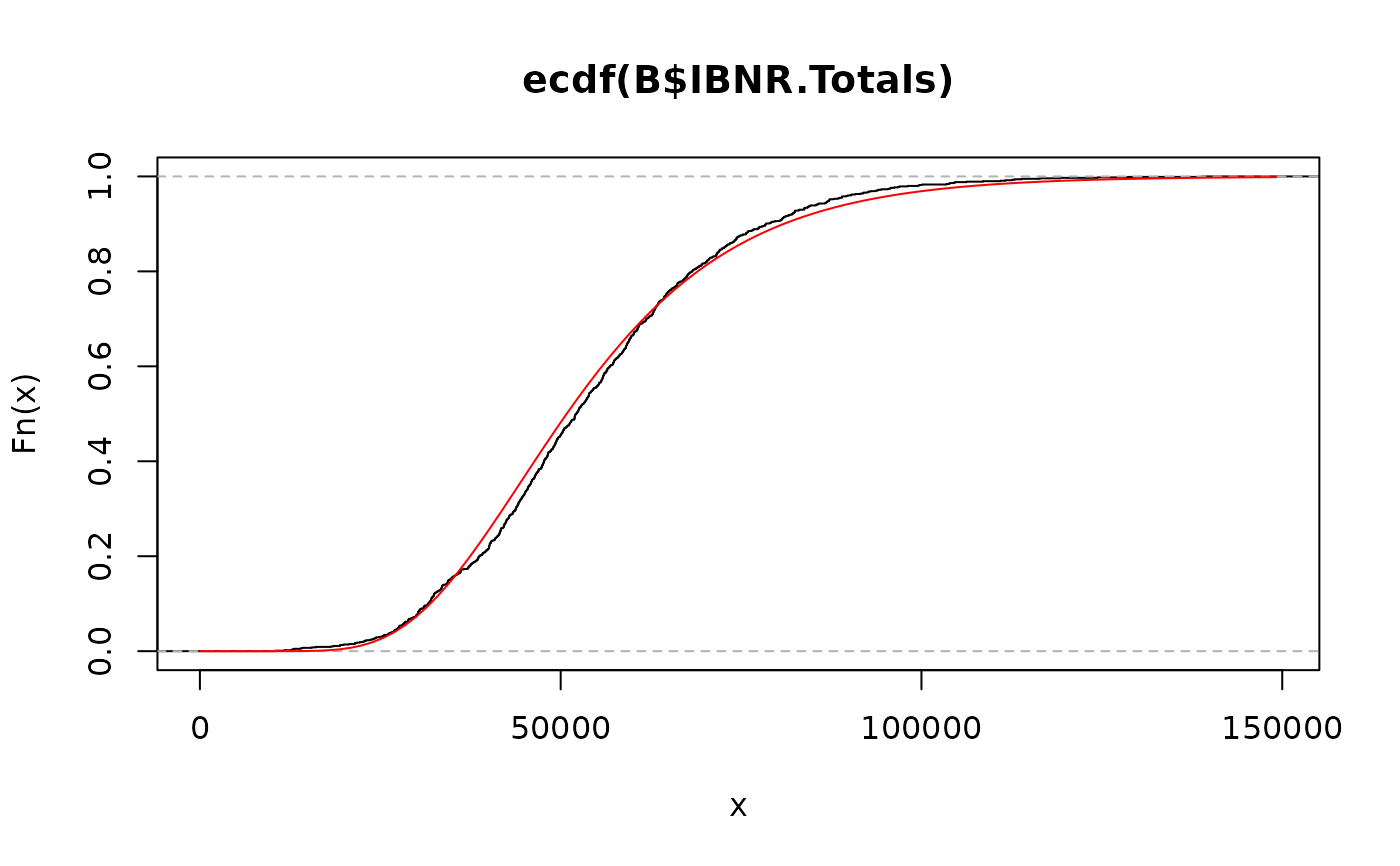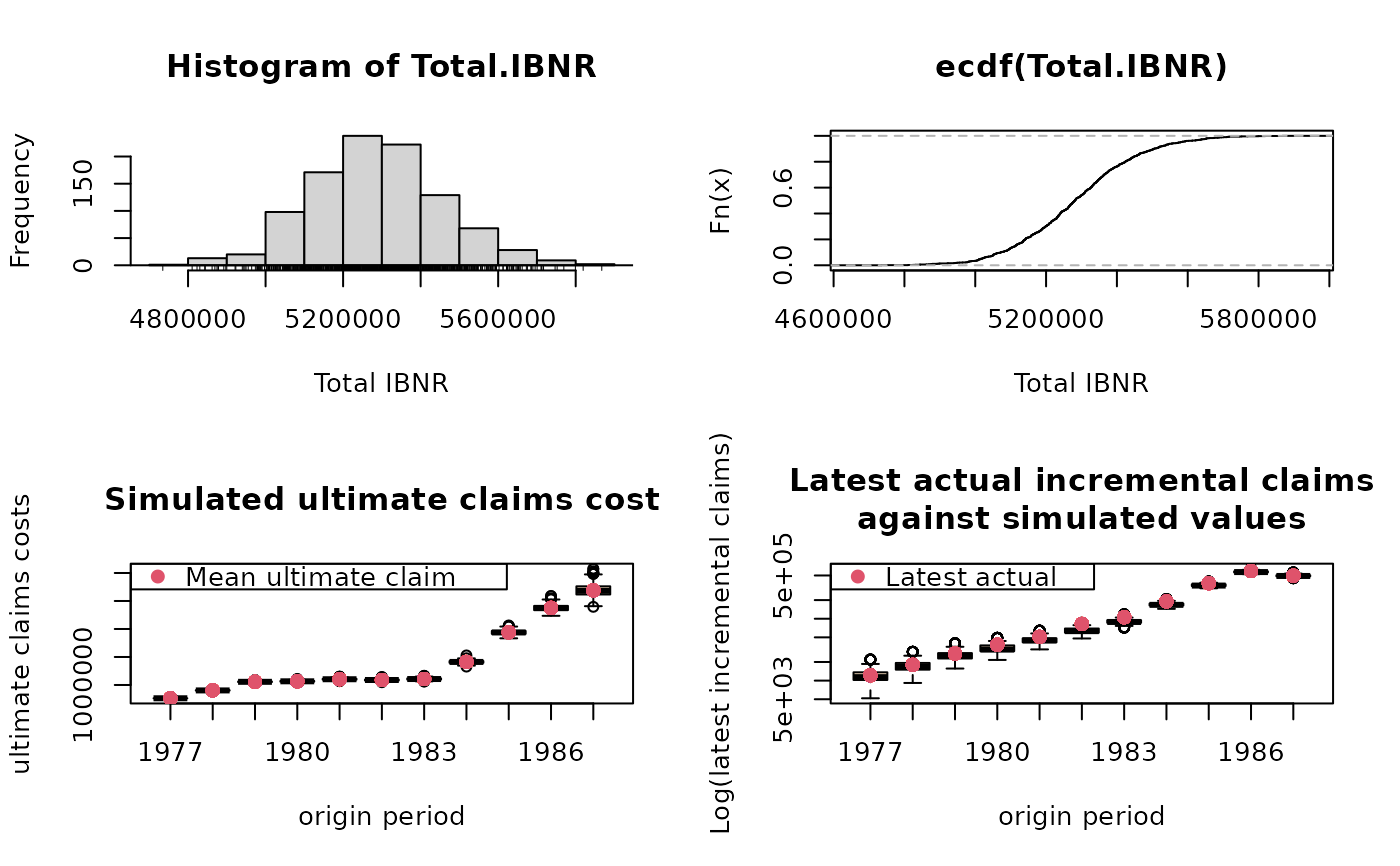
Bootstrap-Chain-Ladder Model
BootChainLadder.RdThe BootChainLadder procedure provides a predictive
distribution of reserves or IBNRs for a cumulative claims development triangle.
Usage
BootChainLadder(Triangle, R = 999, process.distr=c("gamma", "od.pois"), seed = NULL)Arguments
- Triangle
cumulative claims triangle. Assume columns are the development period, use transpose otherwise. A (mxn)-matrix \(C_{ik}\) which is filled for \(k \le n+1-i; i=1,\ldots,m; m\ge n \). See
qpaidfor how to use (mxn)-development triangles with m<n, say higher development period frequency (e.g quarterly) than origin period frequency (e.g accident years).- R
the number of bootstrap replicates.
- process.distr
character string indicating which process distribution to be assumed. One of "gamma" (default), or "od.pois" (over-dispersed Poisson), can be abbreviated
- seed
optional seed for the random generator
Details
The BootChainLadder function uses a two-stage
bootstrapping/simulation approach. In the first stage an ordinary
chain-ladder methods is applied to the cumulative claims triangle.
From this we calculate the scaled Pearson residuals which we bootstrap
R times to forecast future incremental claims payments via the
standard chain-ladder method.
In the second stage we simulate the process error with the bootstrap
value as the mean and using the process distribution assumed.
The set of reserves obtained in this way forms the predictive distribution,
from which summary statistics such as mean, prediction error or
quantiles can be derived.
Value
BootChainLadder gives a list with the following elements back:
- call
matched call
- Triangle
input triangle
- f
chain-ladder factors
- simClaims
array of dimension
c(m,n,R)with the simulated claims- IBNR.ByOrigin
array of dimension
c(m,1,R)with the modeled IBNRs by origin period- IBNR.Triangles
array of dimension
c(m,n,R)with the modeled IBNR development triangles- IBNR.Totals
vector of R samples of the total IBNRs
- ChainLadder.Residuals
adjusted Pearson chain-ladder residuals
- process.distr
assumed process distribution
- R
the number of bootstrap replicates
References
England, PD and Verrall, RJ. Stochastic Claims Reserving in General Insurance (with discussion), British Actuarial Journal 8, III. 2002
Barnett and Zehnwirth. The need for diagnostic assessment of bootstrap predictive models, Insureware technical report. 2007
Author
Markus Gesmann, markus.gesmann@gmail.com
Note
The implementation of BootChainLadder follows closely the
discussion of the bootstrap model in section 8 and appendix 3 of the
paper by England and Verrall (2002).
See also
See also
summary.BootChainLadder,
plot.BootChainLadder displaying results and finally
CDR.BootChainLadder for the one year claims development result.
Examples
# See also the example in section 8 of England & Verrall (2002) on page 55.
B <- BootChainLadder(RAA, R=999, process.distr="gamma")
B
#> BootChainLadder(Triangle = RAA, R = 999, process.distr = "gamma")
#>
#> Latest Mean Ultimate Mean IBNR IBNR.S.E IBNR 75% IBNR 95%
#> 1981 18,834 18,834 0 0 0 0
#> 1982 16,704 16,874 170 751 213 1,435
#> 1983 23,466 24,088 622 1,240 1,039 3,089
#> 1984 27,067 28,785 1,718 1,915 2,758 5,461
#> 1985 26,180 29,085 2,905 2,387 4,148 7,509
#> 1986 15,852 19,561 3,709 2,476 5,189 8,102
#> 1987 12,314 17,835 5,521 3,089 7,197 11,348
#> 1988 13,112 24,170 11,058 4,920 13,952 19,626
#> 1989 5,395 16,271 10,876 5,920 14,529 21,221
#> 1990 2,063 19,929 17,866 14,195 25,820 43,213
#>
#> Totals
#> Latest: 160,987
#> Mean Ultimate: 215,431
#> Mean IBNR: 54,444
#> IBNR.S.E 18,711
#> Total IBNR 75%: 65,615
#> Total IBNR 95%: 87,033
plot(B)
 # Compare to MackChainLadder
MackChainLadder(RAA)
#> MackChainLadder(Triangle = RAA)
#>
#> Latest Dev.To.Date Ultimate IBNR Mack.S.E CV(IBNR)
#> 1981 18,834 1.000 18,834 0 0 NaN
#> 1982 16,704 0.991 16,858 154 143 0.928
#> 1983 23,466 0.974 24,083 617 592 0.959
#> 1984 27,067 0.943 28,703 1,636 713 0.436
#> 1985 26,180 0.905 28,927 2,747 1,452 0.529
#> 1986 15,852 0.813 19,501 3,649 1,995 0.547
#> 1987 12,314 0.694 17,749 5,435 2,204 0.405
#> 1988 13,112 0.546 24,019 10,907 5,354 0.491
#> 1989 5,395 0.336 16,045 10,650 6,332 0.595
#> 1990 2,063 0.112 18,402 16,339 24,566 1.503
#>
#> Totals
#> Latest: 160,987.00
#> Dev: 0.76
#> Ultimate: 213,122.23
#> IBNR: 52,135.23
#> Mack.S.E 26,880.74
#> CV(IBNR): 0.52
quantile(B, c(0.75,0.95,0.99, 0.995))
#> $ByOrigin
#> IBNR 75% IBNR 95% IBNR 99% IBNR 99.5%
#> 1981 0.0000 0.000 0.000 0.000
#> 1982 213.3995 1435.471 2841.149 3733.411
#> 1983 1039.0556 3089.224 4612.046 4945.226
#> 1984 2758.0100 5461.188 7326.144 8210.354
#> 1985 4147.8889 7508.974 9486.665 10451.706
#> 1986 5188.7194 8101.653 11425.500 12991.492
#> 1987 7196.7695 11348.087 14662.543 15553.875
#> 1988 13952.0263 19625.821 25384.471 27311.402
#> 1989 14529.3956 21220.849 27990.618 30039.953
#> 1990 25819.5193 43212.773 59326.863 69688.238
#>
#> $Totals
#> Totals
#> IBNR 75%: 65614.56
#> IBNR 95%: 87033.25
#> IBNR 99%: 105598.78
#> IBNR 99.5%: 113236.29
#>
# fit a distribution to the IBNR
library(MASS)
plot(ecdf(B$IBNR.Totals))
# fit a log-normal distribution
fit <- fitdistr(B$IBNR.Totals[B$IBNR.Totals>0], "lognormal")
fit
#> meanlog sdlog
#> 10.843118752 0.361345937
#> ( 0.011432480) ( 0.008083984)
curve(plnorm(x,fit$estimate["meanlog"], fit$estimate["sdlog"]), col="red", add=TRUE)
# Compare to MackChainLadder
MackChainLadder(RAA)
#> MackChainLadder(Triangle = RAA)
#>
#> Latest Dev.To.Date Ultimate IBNR Mack.S.E CV(IBNR)
#> 1981 18,834 1.000 18,834 0 0 NaN
#> 1982 16,704 0.991 16,858 154 143 0.928
#> 1983 23,466 0.974 24,083 617 592 0.959
#> 1984 27,067 0.943 28,703 1,636 713 0.436
#> 1985 26,180 0.905 28,927 2,747 1,452 0.529
#> 1986 15,852 0.813 19,501 3,649 1,995 0.547
#> 1987 12,314 0.694 17,749 5,435 2,204 0.405
#> 1988 13,112 0.546 24,019 10,907 5,354 0.491
#> 1989 5,395 0.336 16,045 10,650 6,332 0.595
#> 1990 2,063 0.112 18,402 16,339 24,566 1.503
#>
#> Totals
#> Latest: 160,987.00
#> Dev: 0.76
#> Ultimate: 213,122.23
#> IBNR: 52,135.23
#> Mack.S.E 26,880.74
#> CV(IBNR): 0.52
quantile(B, c(0.75,0.95,0.99, 0.995))
#> $ByOrigin
#> IBNR 75% IBNR 95% IBNR 99% IBNR 99.5%
#> 1981 0.0000 0.000 0.000 0.000
#> 1982 213.3995 1435.471 2841.149 3733.411
#> 1983 1039.0556 3089.224 4612.046 4945.226
#> 1984 2758.0100 5461.188 7326.144 8210.354
#> 1985 4147.8889 7508.974 9486.665 10451.706
#> 1986 5188.7194 8101.653 11425.500 12991.492
#> 1987 7196.7695 11348.087 14662.543 15553.875
#> 1988 13952.0263 19625.821 25384.471 27311.402
#> 1989 14529.3956 21220.849 27990.618 30039.953
#> 1990 25819.5193 43212.773 59326.863 69688.238
#>
#> $Totals
#> Totals
#> IBNR 75%: 65614.56
#> IBNR 95%: 87033.25
#> IBNR 99%: 105598.78
#> IBNR 99.5%: 113236.29
#>
# fit a distribution to the IBNR
library(MASS)
plot(ecdf(B$IBNR.Totals))
# fit a log-normal distribution
fit <- fitdistr(B$IBNR.Totals[B$IBNR.Totals>0], "lognormal")
fit
#> meanlog sdlog
#> 10.843118752 0.361345937
#> ( 0.011432480) ( 0.008083984)
curve(plnorm(x,fit$estimate["meanlog"], fit$estimate["sdlog"]), col="red", add=TRUE)
 # See also the ABC example in Barnett and Zehnwirth (2007)
A <- BootChainLadder(ABC, R=999, process.distr="gamma")
A
#> BootChainLadder(Triangle = ABC, R = 999, process.distr = "gamma")
#>
#> Latest Mean Ultimate Mean IBNR IBNR.S.E IBNR 75% IBNR 95%
#> 1977 762,544 762,544 0 0 0 0
#> 1978 889,022 903,785 14,763 5,294 17,870 25,088
#> 1979 1,019,932 1,057,485 37,553 8,255 42,584 52,947
#> 1980 1,002,134 1,066,375 64,241 10,251 70,679 81,667
#> 1981 1,002,194 1,102,771 100,577 11,906 108,005 121,005
#> 1982 944,614 1,088,751 144,137 15,090 153,149 169,439
#> 1983 895,700 1,108,749 213,049 17,306 225,902 241,604
#> 1984 1,024,228 1,410,477 386,249 24,510 402,307 427,184
#> 1985 1,173,448 1,939,010 765,562 37,797 790,815 829,805
#> 1986 1,011,178 2,374,197 1,363,019 62,695 1,402,463 1,468,146
#> 1987 496,200 2,695,177 2,198,977 115,211 2,271,713 2,406,393
#>
#> Totals
#> Latest: 10,221,194
#> Mean Ultimate: 15,509,321
#> Mean IBNR: 5,288,127
#> IBNR.S.E 185,304
#> Total IBNR 75%: 5,410,706
#> Total IBNR 95%: 5,601,874
plot(A, log=TRUE)
# See also the ABC example in Barnett and Zehnwirth (2007)
A <- BootChainLadder(ABC, R=999, process.distr="gamma")
A
#> BootChainLadder(Triangle = ABC, R = 999, process.distr = "gamma")
#>
#> Latest Mean Ultimate Mean IBNR IBNR.S.E IBNR 75% IBNR 95%
#> 1977 762,544 762,544 0 0 0 0
#> 1978 889,022 903,785 14,763 5,294 17,870 25,088
#> 1979 1,019,932 1,057,485 37,553 8,255 42,584 52,947
#> 1980 1,002,134 1,066,375 64,241 10,251 70,679 81,667
#> 1981 1,002,194 1,102,771 100,577 11,906 108,005 121,005
#> 1982 944,614 1,088,751 144,137 15,090 153,149 169,439
#> 1983 895,700 1,108,749 213,049 17,306 225,902 241,604
#> 1984 1,024,228 1,410,477 386,249 24,510 402,307 427,184
#> 1985 1,173,448 1,939,010 765,562 37,797 790,815 829,805
#> 1986 1,011,178 2,374,197 1,363,019 62,695 1,402,463 1,468,146
#> 1987 496,200 2,695,177 2,198,977 115,211 2,271,713 2,406,393
#>
#> Totals
#> Latest: 10,221,194
#> Mean Ultimate: 15,509,321
#> Mean IBNR: 5,288,127
#> IBNR.S.E 185,304
#> Total IBNR 75%: 5,410,706
#> Total IBNR 95%: 5,601,874
plot(A, log=TRUE)
 ## One year claims development result
CDR(A)
#> IBNR IBNR.S.E CDR(1)S.E CDR(1)75% CDR(1)95%
#> 1977 0.00 0.000 0.000 0.00 0.00
#> 1978 14763.08 5293.531 5293.531 17869.54 25088.26
#> 1979 37553.24 8254.537 6670.831 41693.24 49736.98
#> 1980 64241.28 10251.176 7124.744 68509.36 77242.89
#> 1981 100576.54 11906.450 7873.762 105120.26 114376.66
#> 1982 144136.73 15090.436 9068.888 149663.92 160039.16
#> 1983 213049.04 17306.429 10684.855 219417.74 229909.23
#> 1984 386248.57 24509.999 15084.542 396311.31 412522.67
#> 1985 765562.32 37796.824 24428.579 782617.15 805892.09
#> 1986 1363019.41 62694.798 43786.860 1390328.35 1435838.51
#> 1987 2198976.82 115211.158 95813.485 2260987.08 2356162.85
#> Total 5288127.03 185304.355 138056.793 5369950.29 5522206.57
## One year claims development result
CDR(A)
#> IBNR IBNR.S.E CDR(1)S.E CDR(1)75% CDR(1)95%
#> 1977 0.00 0.000 0.000 0.00 0.00
#> 1978 14763.08 5293.531 5293.531 17869.54 25088.26
#> 1979 37553.24 8254.537 6670.831 41693.24 49736.98
#> 1980 64241.28 10251.176 7124.744 68509.36 77242.89
#> 1981 100576.54 11906.450 7873.762 105120.26 114376.66
#> 1982 144136.73 15090.436 9068.888 149663.92 160039.16
#> 1983 213049.04 17306.429 10684.855 219417.74 229909.23
#> 1984 386248.57 24509.999 15084.542 396311.31 412522.67
#> 1985 765562.32 37796.824 24428.579 782617.15 805892.09
#> 1986 1363019.41 62694.798 43786.860 1390328.35 1435838.51
#> 1987 2198976.82 115211.158 95813.485 2260987.08 2356162.85
#> Total 5288127.03 185304.355 138056.793 5369950.29 5522206.57